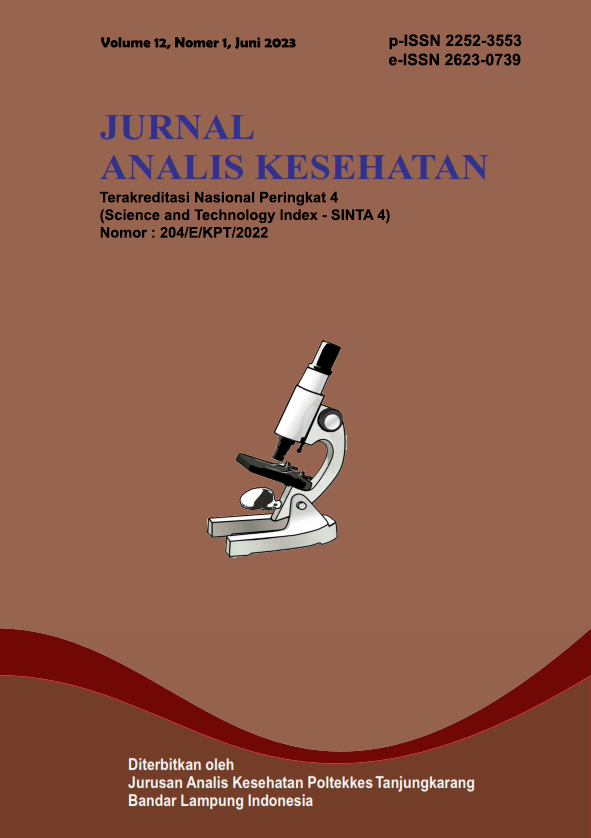Perbandingan Daya Hambat Ekstrak Metanol Daun dan Akar Tanaman Ona cina (Lantana camara) Terhadap Pertumbuhan Staphylococcus aureus dan Pseudomonas aeruginosa
DOI:
https://doi.org/10.26630/jak.v12i1.3695Keywords:
antibacteria, methanol extract, ona cinaAbstract
Ona cina (Lantana camara) is a plant that has the ability as an anti-bacterial. The bioactive compounds of the ona cina plant as anti-bacterial are flavonols and lantanilic acid. This study aimed to compared the methanol extract of the leaves and roots of the ona cina plant in inhibiting the growth of Staphylococcus aureus and Pseudomonas aeruginosa. This research is a laboratory experimental study using the well diffusion method with 24 treatments. The treatment was repeated 2 times with various concentrations of 0.5%, 5%, 10%, 25%, and 50%, and erythromycin as a positive control and aquades as a negative control. The methanol extract of the leaves and roots of the ona cina plant was obtained from the maceration process with methanol solvent, then the growth inhibition test was carried out on the test bacteria. The parameters observed were the clear zone formed around the well.The diameter of the inhibition zone for the growth of the test bacteria at all concentrations of the leaf methanol extract of the ona cina plant was 0 mm while for the methanol extract of the ona cina plant root, the diameter of the inhibition zone on the growth of Staphylococcus aureus at a concentration of 2.5% was 17 mm and the highest is found at a concentration of 50% of 25 mm. While the lowest inhibition zone of root methanol extract on the growth of Pseudomonas aeruginosa was at a concentration of 2.5% at 22 mm and the highest was at a concentration of 50% at 30 mm. The methanol extract of the leaves of the ona cina plant did not have the ability to inhibit the growth of the test bacteria. However, the methanol extract of the ona cina root has the ability to inhibit the growth of Staphylococcus aureus and Pseudomonas aeruginosa.References
Al -Fadhli, A. A., & Nasser, J. A. (2014). Constituents from the root of lantana camara. Asian Journal of Chemistry, 26(23), 8019–8021. https://doi.org/10.14233/ajchem.2014.16935
Azwanida, N. (2015). Medicinal & Aromatic Plants A Review on the Extraction Methods Use in Medicinal Plants , Principle , Strength and Limitation. Medicinal & Aromatic Plants, 4(3), 3–8. https://doi.org/10.4172/2167-0412.1000196
Barreto, F. S., Sousa, E. O., Campos, A. R., Costa, J. G. I., & Rodrigues, F. F. M. (2010). Antibacterial Activity of Lantana camara Linn and Lantana montevidensis Brig Extracts from Cariri-Ceará , Brazil. Journal of Young Pharmacists, 2(1), 42–44. https://doi.org/10.4103/0975-1483.62211
Bhagirath, A. Y., Li, Y., Somayajula, D., Dadashi, M., Badr, S., & Duan, K. (2016). Cystic fibrosis lung environment and Pseudomonas aeruginosa infection. BMC Pulmonary Medicine, 16(1), 1–22. https://doi.org/10.1186/s12890-016-0339-5
CDC. (2019). Antibiotic Resistance Threats in the United States 2019. Atlanta, GA.
Champoux, J. J., Neidhardt, F. C., Drew, W. L., & Plorde, J. J. (2004). Sheris Medical Microbiology. (K. J. Ryan & C. G. Ray, Eds.), Clinical Infectious Disease (4th ed.). United States of America: MCGRAW-HILL. https://doi.org/10.1017/CBO9780511722240.150
Cowan, M. M. (1999). Plant products as antimicrobial agents. Clinical Microbiology Reviews, 12(4), 564–582. https://doi.org/10.1128/cmr.12.4.564
Dahesih dewi, A., Puspa Dewi, Y., Sugainli, A. K., & Parwati, I. (2019). Surveilans Bakteri Resistan Multi Obat Dan Kepekaannya Terhadap Antibiotik Di Rumah Sakit Indonesia Tahun 2018. Departemen Patologi Klinik dan Kedokteran Laboratorium Fakultas Kedokteran Kesehatan Masyarakat dan Keperawatan Universitas Gadjah Mada. Depok: Departemen Patologi Klinik dan Kedokteran Laboratorium Fakultas Kedokteran Kesehatan Masyarakat dan Keperawatan Universitas Gadjah Mada.
Dou, Y., Huan, J., Guo, F., Zhou, Z., & Shi, Y. (2017). Pseudomonas aeruginosa prevalence, antibiotic resistance and antimicrobial use in Chinese burn wards from 2007 to 2014. Journal of International Medical Research, 45(3), 1124–1137. https://doi.org/10.1177/0300060517703573
Jhariya, S., & Kakkar, A. (2016). Antibacterial Activity of Root Bark Of Lantana Camara. International Journal of CHEMICAL AND PHARMACEUTICAL ANALYSIS, 3(3), 1–7.
Kakkar, M., Chatterjee, P., Chauhan, A. S., Grace, D., Lindahl, J., Beeche, A., … Chotinan, S. (2018). Antimicrobial resistance in South East Asia: time to ask the right questions. Global Health Action, 11(1). https://doi.org/10.1080/16549716.2018.1483637
Kebede, T., Kibret, F., Fikre, M., & Endale Milkyas. (2015). Phytochemical Screening and Characterization of Olean-18-ene Type Triterpeniod from the Roots of Lantana camara. Science, Technology and Arts Research Journal, 4(1), 91–94.
Manjang, Y., & Aziz, H. (2015). Structure elucidation of brine shrimp toxic compound from Lantana camara L . leaves Structure elucidation of brine shrimp toxic compound from Lantana camara L . leaves. Journal of Chemical and Pharmaceutical Research, 7(12), 251.
Menaldi, S. L. S., Bramono, K., & Indriatmi, W. (2015). Ilmu Penyakit kulit dan kelamin. Badan Penerbit FKUI (7th ed.). Jakarta.
Muthulaksmi, G., & Neelanarayanan, P. (2019). Screening of phytoconstituents and antibacterial efficacy of leaves extracts of Lantana camara, 8(6), 718–722.
Naz, R., & Bano, A. (2013). Phytochemical screening, antioxidants and antimicrobial potential of Lantana camara in different solvents. Asian Pacific Journal of Tropical Disease, 3(6), 480–486. https://doi.org/10.1016/S2222-1808(13)60104-8
Nurrani, L. (2013). Pemanfaatan tradisional tumbuhan alam berkhasiat obat oleh masyarakat di sekitar cagar alam tangale. Info BPK Manado, 3(1), 1–22. https://doi.org/10.1103/PhysRevA.86.060301
Parwati, P., Ridhay, A., & Syamsuddin, S. (2019). Uji Aktivitas Antibakteri Ekstrak Daun Tembelekan (Lantana camara Linn) Dari Beberapa Tingkat Kepolaran Pelarut. KOVALEN: Jurnal Riset Kimia, 5(1), 39–47. https://doi.org/10.22487/kovalen.2019.v5.i1.10111
Serra, R., Grande, R., Butrico, L., Rossi, A., Settimio, U. F., Caroleo, B., … De Franciscis, S. (2015). Chronic wound infections: The role of Pseudomonas aeruginosa and Staphylococcus aureus. Expert Review of Anti-Infective Therapy, 13(5), 605–613. https://doi.org/10.1586/14787210.2015.1023291
Sousa, E. O., Miranda, C. M. B. A., Nobre, C. B., Boligon, A. A., Athayde, M. L., & Costa, J. G. M. (2015). Phytochemical analysis and antioxidant activities of lantana camara and lantana montevidensis extracts. Industrial Crops and Products, 70(8), 7–15. https://doi.org/10.1016/j.indcrop.2015.03.010
Tuntun, M. (2016). Uji efektivitas ekstrak daun pepaya (Carica papaya L.) terhadap pertumbuhan bakteri Escherichia coli dan Staphylococcus aureus. Jurnal Analis Kesehatan,7(3), 497-502.
WHO. (2014). World Health Organization Antimicrobial resistance: global report on surveillance 2014. Geneva, Switzerland.
Downloads
Additional Files
Published
Issue
Section
License

Jurnal Analisis Kesehatan is licensed under a Creative Commons Attribution-ShareAlike 4.0 International License.
Based on a work at https://ejurnal.poltekkes-tjk.ac.id/index.php/JANALISKES.








